UP Board Class 9 Science Notes For Chapter 11 Sound
We hear sound from various sources, For Example. from humans, birds, machines, vehicles, TV, radio, etc. Sound is a form of energy which produces a sensation of hearing in our ears.
- A sound is produced by vibrating objects. Vibration means a kind of rapid-to-and-fro motion of an object. The sound of the human voice is produced due to vibrations in the vocal cords.
- We can produce sound by striking the tuning fork, by plucking, scratching, rubbing, blowing or shaking different objects. They all produce sound due to vibrations.
UP Board Class 9 Science Notes For Chapter 11 Sound Propagation Of Sound
- When an object vibrates, it sets the particles of the medium (solid, liquid or gas) around it in vibrations. The particles do not travel from the vibrating object to the ear. A particle of the medium in contact with the vibrating object is first displaced from its equilibrium position.
- It then exerts a force on the adjacent particle. As a result of which, the adjacent particle gets displaced from its position of rest.
- After displacing the adjacent particle, the first particle comes back to its original position. This process continues in the medium till the sound reaches our ear.
- The source of sound creates a disturbance in the medium which travels through the medium. The particles of the medium do not move forward but the disturbance is carried forward.
- This is the propagation of sound in a medium, hence sound can be visualised as a wave. Sound waves require a medium to travel, so they are called mechanical waves.
Read and Learn More Class 9 Science Notes
Formation of Compression and Rarefaction in Air
- When a vibrating object moves forward in the air, it pushes and compresses the air in front of it, creating a compression which starts to move away from the vibrating object. When the vibrating object moves backwards, it creates rarefaction.
- Compression is the part of a longitudinal wave in which the particles of the medium are closer to one another than they normally are and it is the region of high pressure. It is denoted by C in the figure given here.
- Rarefaction is the part of a longitudinal wave in which the panicles of the medium arc are farther apart than they normally arc and it is the region of low pressure. It is denoted by R in the figure given here.
- A vibrating object creates a series of compressions (C) and rarefactions (R) in the medium
- As the object moves back and forth rapidly, a series of compressions and rarefactions are created in the air.
- Thus, the propagation of sound can be visualised as the propagation of density variations or pressure variations in the medium as pressure is related to the number of particles of a medium in a given volume. More density of the particles in the medium gives more pressure and vice-versa.
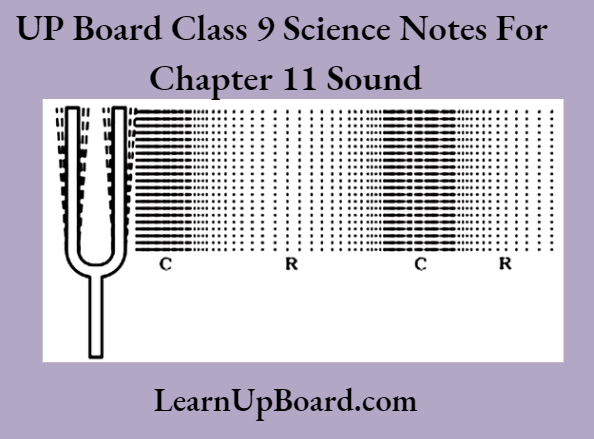
UP Board Class 9 Science Notes For Chapter 11 Sound Types Of Waves
There are mainly two types of waves.
Longitudinal Waves
- In longitudinal waves, the individual particles of the medium move in a direction parallel to the direction of propagation of the disturbance.
- The particles do not move from one place to another but they simply oscillate back and forth about their positions of rest.
- This is exactly how a sound wave propagates, hence sound waves are longitudinal waves. Longitudinal waves can be produced in all three media such as solids, liquids and gases.
- The waves which travel along a spring when it is pushed and pulled at one end, are the longitudinal waves.
- When coils are closer together than normal, compressions (C) are observed in spring. When coils arc farther apart than normal, rarefactions (R) are observed.
- A long flexible spring which can be compressed or extended easily is called a slinky.
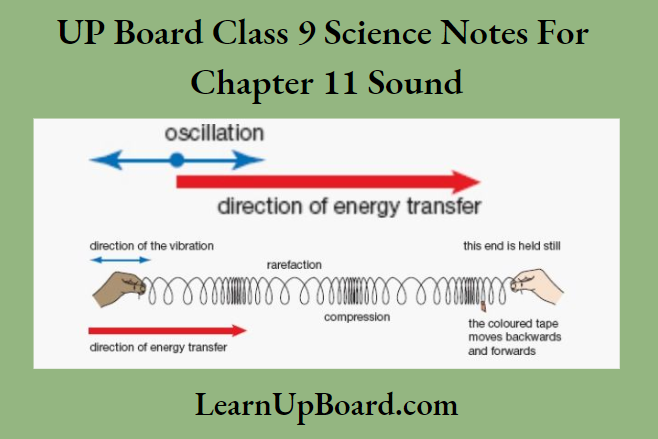
Transverse Waves
- In transverse waves, the individual particles of the medium move about their mean position in a direction perpendicular to the direction of wave propagation, For Example. Light is a transverse wave (but it is not a mechanical wave i.e. it does not require a medium for its propagation).
- Transverse waves can be produced only in solids and liquids but not in gases.
- The waves produced by moving one end of a long spring or rope, up and down rapidly, whose other end is fixed, are transverse waves.
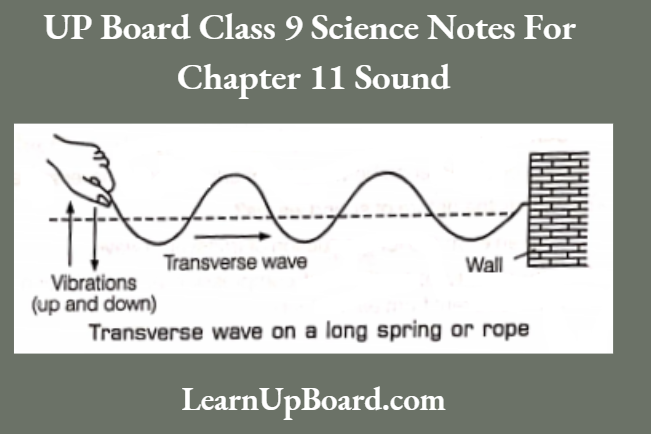
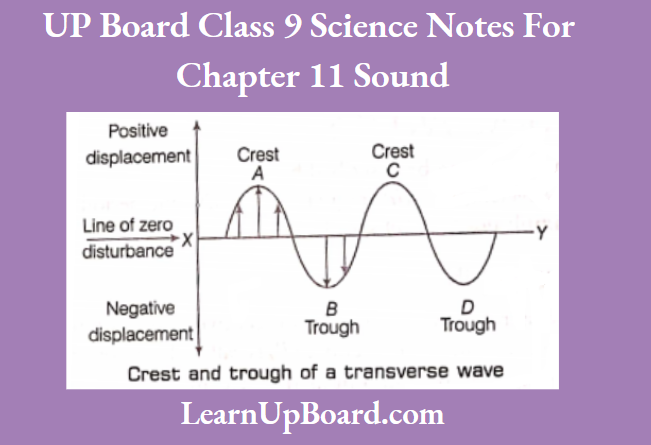
Graphical Representation of a Sound Wave
- When a sound wave passes through the air, the density of air changes continuously.
- A sound Wave in hr has been represented using a density-distance graph as shown below.
- A sound wave in the air by density-distance graph
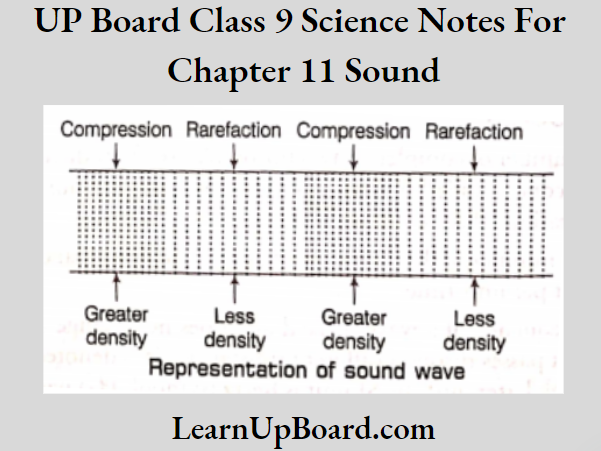
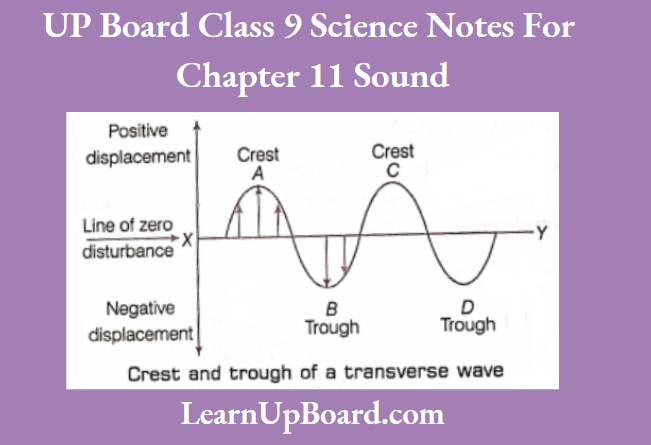
UP Board Class 9 Science Notes For Chapter 11 Sound Terms to Describe Sound Waves
Sound waves can be described by its
- Wavelength
- Frequency
- Time period
- Amplitude
- Speed
Wavelength
- The distance between the two consecutive compressions (C) or two consecutive rarefactions (R) is called the wavelength. Wavelength is the minimum distance in which a sound wave repeats itself.
- In other words, it is the combined length of a compression and an adjacent rarefaction. It is represented by a Greek letter lambda X. Its SI unit is metre (m).
Frequency
- The number of complete waves (or oscillations) produced in one second is called the frequency of the wave. It is the number of vibrations that occur per second.
- Or the number of compressions or rarefactions that cross a point per unit of time.
- The frequency of a wave is fixed and does not change even when it passes through different substances. It is denoted by v (Greek letter, nu). Its SI unit is hertz (symbol, Hz) named in honour of Heinrich Rudolf Hertz who discovered the photoelectric effect.
Time Period
- The time taken by two consecutive companion* or rarefactions to cross a fixed point is called the period of the wave.
- In other words, the time required to produce one complete wave (or oscillations) is called the period of the wave. It is denoted by the symbol T. Its SI unit is second (s).
- The time period of a wave is the reciprocal of its frequency, Time period(T)=\(\frac{1}{\text { Frequency }(v)}\)
Amplitude
- The maximum displacement of the particles of the medium from their original mean positions on passing a wave through the medium is called the amplitude of the wave.
- It is used to describe the size of the wave. It is usually denoted by the letter A. Its SI unit is metre (m). The amplitude of a wave is the same as the amplitude of the vibrating body producing the wave.
Speed
- The distance travelled by a wave in one second is called the speed of the wave or the velocity of the wave. Under the same physical conditions, the speed of sound remains the same for all frequencies.
- It is represented by the letter v. Its SI unit is metres per second (m/s or ms-1).
- Relationship between speed, frequency and wavelength of a wave: Speed =\(\frac{\text { Distance travelled }}{\text { Time taken }}\)
- Suppose the distance travelled by a wave is X (wavelength), in time T, then the speed is given byv=XJT We know that, frequency, v = 1 IT Therefore, y=A.xvor v=vX
Example 1. Sound waves travel in the air with a speed of about 330 ms-1. Calculate the wavelength of sound whose frequency is 550 Hz. Calculate the period of one oscillation.
Answer:
Given,
Sound waves travel in the air with a speed of about 330 ms-1.
the frequency of sound, v = 550 Hz
Speed of sound wave, v=330 ms-1
The wavelength of the sound wave, X =?
Time period, T=?
We know that, r-v \(\lambda\) and \(\tau-1 / v\)
As. r-v \(\lambda \Rightarrow \lambda=\frac{r}{v}-\frac{330}{550}=\frac{3}{5}=0.6 \mathrm{~m}\)
Asain, T=\(\frac{1}{v}=\frac{1}{550}=0.001 \mathrm{~s}\)
Characteristics of Sound
A sound has three characteristics. These are loudness, pitch and quality (or timbre).
Loudness
- It is the measure of the sound energy reaching the ear per second. The greater the sound energy reaching our ear per second, the louder the sound will appear to be.
- If the sound waves have a small amplitude, then the sound will be faint or soft but, if waves have a large amplitude then the sound will be loud. The figure given above shows the wave shapes of a loud and a soft sound of the same frequency.
- Since the amplitude of a sound wave is equal to the amplitude of vibrations of the source producing the sound waves, hence the loudness of sound depends on the amplitude of vibrations of the source producing the sound waves. Loud sound can travel a larger distance as it is associated with higher energy.
- A sound wave spreads out from its source, as it moves away from the source, its amplitude as well as its loudness decreases. The loudness of sound is measured in decibels dB). It depends on the sensitivity or the response of our ears.
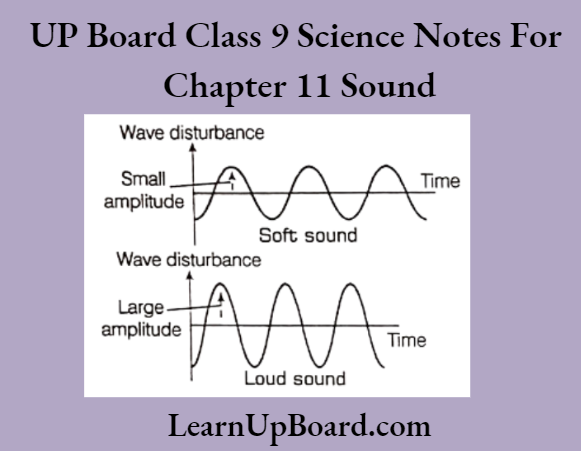
Intensity
- The amount of sound energy passing each second through the unit area is known as the intensity of sound. Loudness and intensity are not the same terms. Loudness is a measure of the response of the car to the sound.
- Even when two sounds are of equal intensity, we may hear one as louder than the other, simply because our car detects it in a better way.
- The SI unit of intensity is watt per square metre (W/m²).
(3) Quality or Timbre
The quality or timbre of sound enables us to distinguish one sound from another having the same pitch and loudness. A sound of a single frequency is called a tone.
The sound produced due to a mixture of several frequencies is called a note and is pleasant to listen to. Noise is unpleasant to the ear. Music is pleasant to hear and is of rich quality.
Speed of Sound and Light
- The speed of sound in air is about 344 ms-1 at 22°C and 331 ms-1 at 0°C and the speed of light in air is 300000000 ms 1 or 3 x 108 ms-1. Thus, the speed of light is very high as compared to the speed of sound.
- This is the reason why in the rainy season, the flash of lightning is seen first and the sound of thunder is heard a little later, though both are produced at the same time in clouds.
Speed of Sound in Different Media
The medium through which sound propagates can be a solid substance, a liquid or a gas. The speed of sound depends on the properties of the medium through which it travels and the temperature of the medium.
The speed of sound decreases when we go from a solid to a gaseous state. If the temperature of the medium increases then the speed of sound also increases.
UP Board Class 9 Science Notes For Chapter 11 Sound Reflection Of Sound Wave
The bouncing back of sound when it strikes a hard surface is known as the reflection of sound. It can be reflected from any surface whether it is smooth or rough.
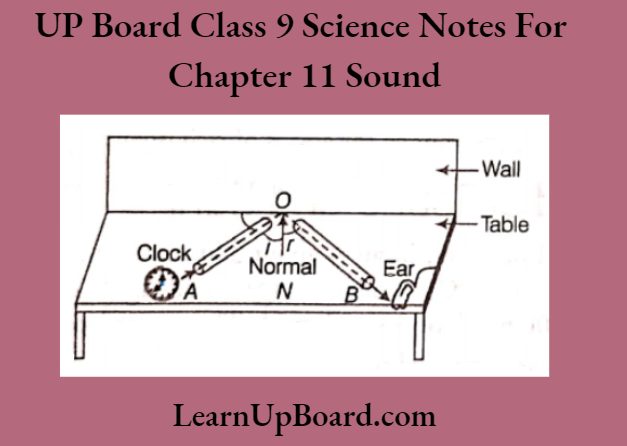
Sound is reflected in the same way as light and follows the same laws of reflection, which are as follows:
- The incident sound wave (AO), the reflected sound wave (OB) and the normal (ON) at the point of incidence, all lie in the same plane.
- The angle of incidence (∠AON) of sound is equal to the angle of reflection (∠NOB) of sound.
Echo
When a person shouts in a big empty hall, we first hear his original sound, after that, we hear the reflected sound of that shout. So, the repetition of sound caused by the reflection of sound waves is called an echo.
The sensation of sound persists in our brain for about 0.1 seconds. Thus, to hear a distinct echo, the time interval between the original sound and the reflected one must be at least 0.1 s.
The distance travelled by the sound in 0.1 s
= speed x time
= 344 x 0.1 = 34.4 m
So, the echo will be heard, if the minimum distance between the source of sound and the obstacle is =\(\frac{34.4}{2} \mathrm{~m}\)=17.2 m
This distance will change with the change in temperature. Echoes may be heard more than once due to successive multiple reflections.
The rolling of thunder is due to successive reflections of sound from a number of reflecting surfaces, such as clouds and the land.
Reverberation
- The persistence of a sound in a big hall due to repeated reflections from the walls, ceiling and floor of the wall is known as reverberation.
- This occurs when the original sound and reflected sound overlap. For reverberation to occur, reflection occurs at less than 17 metres distance.
- A short reverberation is desirable in a concert hall, where music is being played, as it boosts the sound level. However excessive reverberation is highly undesirable because sound becomes blurred, distorted and confusing due to overlapping of different sounds.
- To reduce reverberation, the roof and walls of the auditorium are generally covered with sound-absorbent materials like compressed fibre board, rough plaster or draperies.
Uses of Multiple Reflections of Sound
The reflection of sound is used in the working of devices such as megaphones, horns, stethoscopes and soundboards. These devices involve multiple reflections of sound waves.
(1) Megaphone and Horn
A megaphone is a large cone-shaped device used to amplify and direct the voice of a person who speaks into it. When a person speaks into the narrow end of the megaphone tube, the sound waves produced are prevented from spreading by successive reflections from the wider end of the megaphone tube, hence sound of his voice can be heard over a longer distance.
(2) Stethoscope
It is a medical instrument used by doctors to listen to the sounds produced within the heart and the lungs in the human body. The sound of heartbeats (or lungs) reaches the doctor’s ears through the multiple reflections of sound waves through the stethoscope tube.
Sound Board
- A concave board (curved board) is placed behind the stage in big halls; so that sound after reflecting from the sound hoard, spreads evenly across the width of the hall.
- Generally, the ceilings of concert halls, conference halls and cinema halls are curved, so that sound after reflection reaches all corners of the hall.
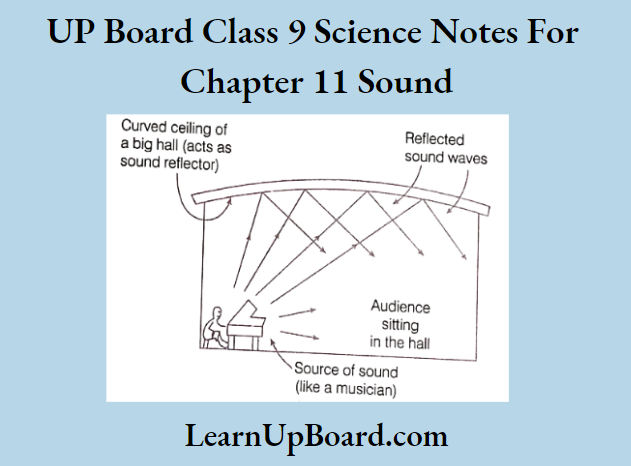
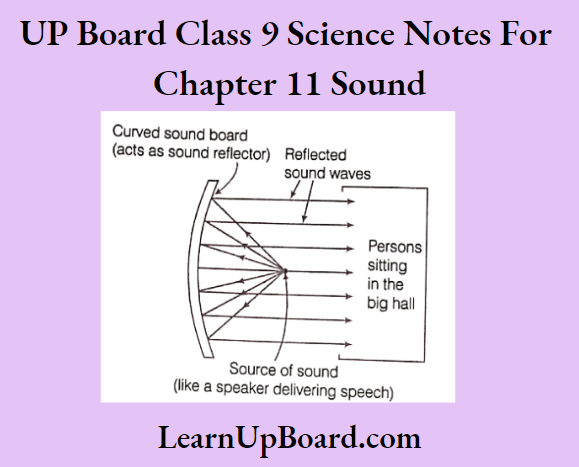
UP Board Class 9 Science Notes For Chapter 11 Sound Range Of Hearing
The average frequency range over which the human ear is sensitive is called the audible range. The audible range of sound for human beings is from 20 Hz to 20,000 Hz (20 kilohertz). Children under the age of 5 and some animals, such as dogs can hear up to 25000 Hz. As people grow older, their ears become less sensitive to higher and lower frequencies.
Infrasonic Sound
- The sound of frequencies lower than 20 Hz is known as infrasonic sounds or infrasound, which cannot be heard by human beings.
- Earthquakes and some animals like whales, elephants and rhinoceroses produce the infrasonic sounds of frequency 5 Hz.
- It is observed that some animals get disturbed and start running here and there just before the earthquakes occur. This is because earthquakes produce low-frequency infrasound before the main shock waves begin which possibly alert the animals and they get disturbed.
Ultrasonic Sound
The sounds of frequencies higher than 20000 Hz are called ultrasonic sounds or ultrasounds which cannot be heard by human beings. Dogs can hear ultrasonic sounds of frequencies up to 50,000 Hz. This is why dogs are used for detective work by the police. Bats, dolphins, and porpoises can produce ultrasonic sounds.
Hearing Aid
This is a device used by people who are hard of hearing. It is an electronic, battery-operated device. It receives sound through a microphone which converts the sound waves to electrical signals. These electrical signals are amplified by an amplifier.
The amplified electrical signals are given to the speaker of the hearing aid. The speaker converts the amplified electrical signals to sound and then sends it to the ear for clear hearing.
Ultrasound and Its Applications
Ultrasounds are high-frequency waves. They travel in a straight line without bending around the corners. They can penetrate into matter to a large extent. Due to these properties, ultrasound is used in industry and in hospitals for medical purposes. Some of the important applications of ultrasound are given below.
In Cleaning Minute Parts of Machines
- Ultrasound is used to clean parts located in hard-to-reach- places, such as spiral tubes, odd-shaped machines electronic components, etc.
- Objects to be cleaned are placed in a cleaning solution and ultrasonic waves are sent into the solution.
- Due to their high frequency, the ultrasound waves stir up the solution, hence the particles of dust, grease and dirt vibrate too much, become loose, get detached from the object and fall into the solution. The objects, thus get thoroughly cleaned.
In Internal Investigation of the Human Body
- Ultrasound is used to investigate the internal organs of the human body such as the liver, gall bladder, pancreas, kidneys, uterus heart, etc.
- Ultrasound waves can penetrate the human body and different types of tissues get reflected in different ways from a region where there is a change of tissue density.
- In this way, ultrasound helps us to see inside the human body and to give pictures of the inner organs by converting them into electrical signals.
- These pictures or images are then displayed on a monitor or printed on a film. This technique is called ultrasonography.
- Ultrasonography is used for the examination of the foetus during pregnancy to detect any growth abnormalities, which helps in taking the necessary action to rectify the abnormalities.
- The ultrasonic scanner is an instrument that helps the doctor to detect abnormalities, such as stones in the gall bladder and kidney or tumours in different organs and many other ailments.
- Ultrasound is also used for diagnosing heart diseases by scanning the heart from inside. This technique is echocardiography. Ultrasound may be employed to break small stones formed in the kidneys into fine grains which later get flushed out with urine. This way, the patient gets relief from pain.
In Industries
- Ultrasound is used in industry for detecting flaws (cracks, etc.) in metal blocks without damaging them.
- Metal blocks are used in the construction of big structures like bridges, machines scientific equipment, etc.
- If there are some cracks and flaws in the metal blocks, which are invisible from the outside reduces the strength of the structure. These can be detected by using ultrasound.
- This is based on the fact that an internal crack (or hole) does not allow ultrasound to pass through it.
- It reflects the ultrasound. Ultrasound waves are allowed to pass through one face of the metal block (to be tested) and detectors are placed on the opposite face of the metal block to detect the transmitted ultrasound waves.
- If there is even a small defect, the ultrasound waves get reflected back indicating the presence of the flaw or defect, as shown
- Ultrasound is reflected from a part of the block, which shows that this metal block has a flaw or defect (like a crack] inside it.
- Ordinary sound waves cannot be used for detecting the flaws in metal blocks because they will bend around the corners of the defective location and therefore enter the detector.
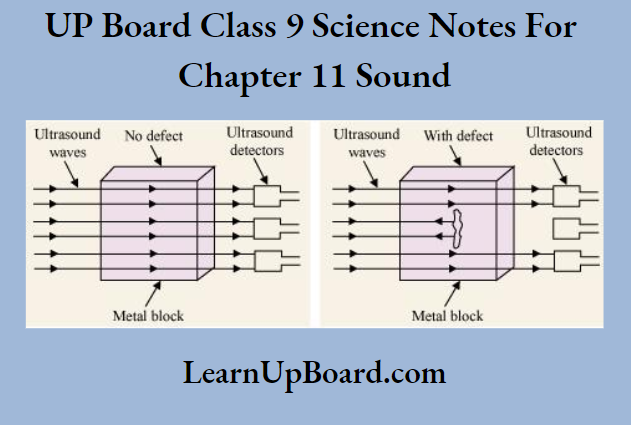
Use of Ultrasonic Waves by Bats
- Bats search out prey and fly in dark night by emitting and detecting reflections of ultrasonic waves.
- The method used by some animals like bats, tortoises and dolphins to locate objects by hearing the echoes of their ultrasonic squeaks is known as echolocation.
- Bats emit high-frequency or high-pitched ultrasonic squeaks while flying and listen to the echoes produced by the reflection of their squeaks from the obstacles or prey in their path.
- From the time taken by the echo to be heard, bats can determine the distance of the obstacle or prey and can avoid the obstacle by changing the direction or catching the prey.
- However, certain moths can hear the high-frequency ultrasonic squeaks of a bat and can know where the bat is flying nearby and are able to escape from being captured.
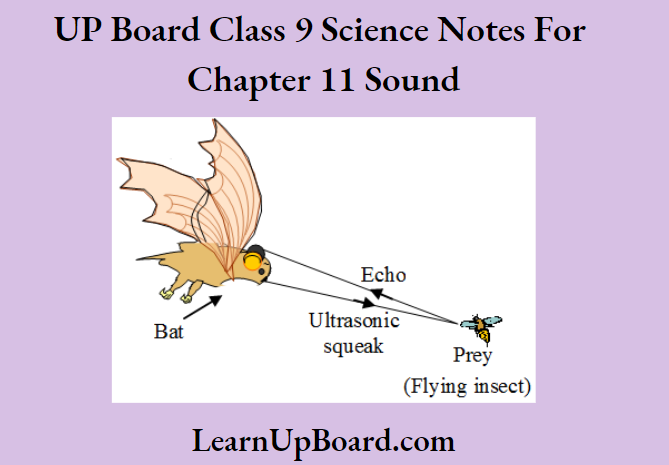
UP Board Class 9 Science Notes For Chapter 11 Sound Questions and Answers
Question 1. How does the sound produced by a vibrating object in a medium reach your ear?
Answer:
- Sound is produced by vibrating objects. When an object vibrates, it sets the particles of the medium around it in vibration.
- Their vibrations are passed or transmitted to neighbouring particles in all directions.
- When vibrations are transmitted by medium particles to our ears, we get the sensation of hearing.
Question 2. Explain, how sound is produced by your school bell.
Answer:
- The bell produces the sound when the gong of the bell is struck by a hammer. When the gong is struck by the hammer, it starts vibrating.
- Since the vibrating objects produce sound, the bell produces sound.
Question 3. Why are sound waves called mechanical waves?
Answer:
Sound waves are called mechanical waves because they are produced by the motion of particles of a medium and require a material medium for their propagation.
Question 4. Suppose you and your friend are on the Moon. Will you be able to hear any sound produced by your friend?
Answer:
- No, I will not be able to hear any sound produced by my friend because the sound waves require some material medium like air to travel.
- There is no atmosphere or air on the Moon, so the sound produced by my friend will not reach me and I will not be able to hear.
Question 5. Which wave property determines (1) loudness (2) pitch?
Answer:
- The loudness of a sound wave is determined by its amplitude.
- The pitch of the sound wave is determined by its frequency.
Question 6. Guess which sound has a higher pitch, guitar or car horn?
Answer:
The pitch of a guitar sound is higher because the frequency of the sound produced by a guitar is higher than that of a car horn.
Question 7. How are the wavelength and frequency of a sound wave related to speed?
Answer:
The relation between wavelength (λ), frequency (v) and speed of wave {v) is v=vλ
Question 8. Calculate the wavelength of a sound wave whose frequency is 200Hz and speed is 440 \(\mathrm{~ms}^{-1}\) in a given medium.
Answer:
Given, frequency, v=200 Hz, velocity, v=440 \(\mathrm{~ms}^{-1}\)
According to the relation, v=\(\mathrm{v}\rangle \Rightarrow \lambda=\frac{v}{\mathrm{v}}\)
= \(\frac{440}{200}=2.2 \mathrm{~m}\)
Question 9. A person is listening to a tone of 500 Hz sitting at a distance of 450 m from the source of the sound, what is the time interval between successive compressions from the source?
Answer:
Given
A person is listening to a tone of 500 Hz sitting at a distance of 450 m from the source of the sound
The time interval between two successive compressions or rarefactions is equal to the time period of the wave.
Required time interval = Time period
=\(\frac{1}{\text { Frequency }}=\frac{1}{500}=0.002 \mathrm{~s}\)
=2 \(\times 10^{-3} \mathrm{~s}=2 \mathrm{~ms}\)
Question 10. Distinguish between loudness and intensity of sound.
Answer:
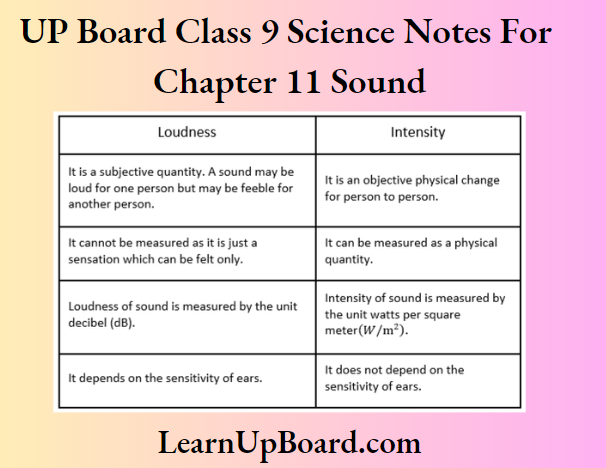
Question 11. An echo returned in 3 s. What is the distance of the reflecting surface from the source, given that the speed of sound is 342 \(\mathrm{~ms}^{-1}\)?
Answer:
Given,
An echo returned in 3 s. What is the distance of the reflecting surface from the source
speed of sound, v=342 \(\mathrm{~ms}^{-1}\)
Time taken, t = 3s
So, distance travelled by sound =v x t
= 342 x 3
=1026 m
Hence, the distance between the reflecting surface and the source should be \(\frac{1026}{2}=513 \mathrm{~m}\)
Question 12. Why are the ceilings of concert halls curved?
Answer:
The Curved ceiling of the conference hall focuses on reflecting sound from the walls to the audience so that every corner of the hall gets sound equivalently.
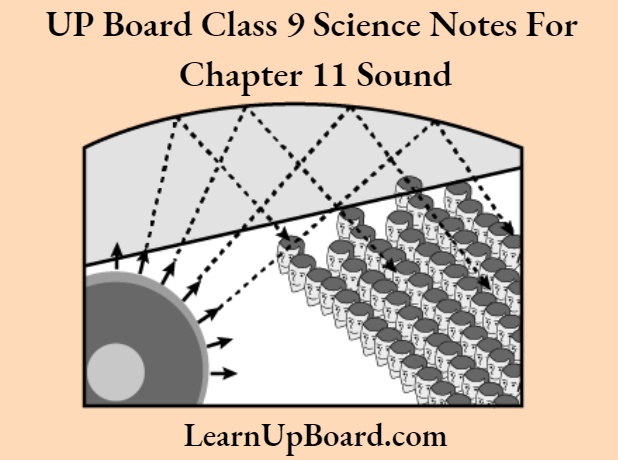
Question 14. What is the audible range of the average human ear?
Answer:
The audible frequency range for the average human car is 20 Hz to 20000 Hz’.
Question 15. What is the range of frequencies associated with (1)Infrasound and (2) ultrasound?
Answer:
- Sound waves having frequencies less than 20 Hz and greater than zero are called infrasound.
- Sound waves having frequencies more than 20000 Hz are called ultrasound.
UP Board Class 9 Science Notes For Chapter 11 Sound Exercises
Question 1. What is sound and how is it produced?
Answer:
Sound
Sound is a form of energy, which produces the sensation of hearing in our ears. It is produced when an object is set to vibrate or we can say that vibrating objects produce sound.
Question 2. Describe with the help of a diagram, how compressions and rarefactions are produced in air near a source of sound.
Answer:
- When a vibrating object moves forward, it pushes the air in front of it creating a region of high pressure. This region is called compression.
- This compression starts to move away from the vibrating object. When the vibrating object moves backwards, it creates a region of low pressure called rarefaction.
- As the object moves back and forth rapidly, a series of compressions and rarefactions is created. These make the sound wave that propagates through the medium.
Question 3. Why is a sound wave called a longitudinal wave?
Answer:
The sound wave is called a longitudinal wave because, on the propagation of a sound wave in a medium, the particles of the medium vibrate to and fro about their equilibrium positions and parallel to the direction of propagation of the wave.
Question 4. Which characteristic of the sound helps you to identify your friend by his voice while sitting with others in a dark room?
Answer:
Timbre, a quality of sound is the characteristic by which we can identify the person by his voice.
Question 5. Flash and thunder are produced simultaneously. But thunder is heard a few seconds after the flash is seen, why?
Answer:
Thunder is heard a few seconds after the flash is seen because the speed of light in the atmosphere (or air) is 3 \(\times 10^8 \mathrm{~ms}^{-1}\) which is very high as compared to the speed of sound which is only 330 \(\mathrm{~ms}^{-1}\). So, the sound of thunder reaches us later than the flash.
Question 6. A person has hearing range from 20 Hz to 20 kHz. What are the typical wavelengths of sound waves Tair corresponding to these two frequencies? (Take, the speed of sound in air as \(\mathrm{~ms}^{-1}\)
Answer:
Given
A person has hearing range from 20 Hz to 20 kHz.
The relation between speed (v), wavelength \((\lambda)\) and frequency (v) of a wave is \(\nu=\mathrm{v} \lambda\)
⇒ \(\lambda=\frac{y}{v}\)
(1) Here, v=344 \(\mathrm{~ms}^{-1}, \mathrm{v}=20 \mathrm{~Hz}\)
Corresponding wavelength,
⇒ \(\lambda=\frac{p}{v}=\frac{344}{20}=17.2 \mathrm{~m}\)
⇒ (2) Here, v=344 \(\mathrm{~ms}^{-1}, \mathrm{v}=20 \mathrm{kHz}=20 \times 10^3 \mathrm{~Hz}\)
Corresponding wavelength, \(\lambda=\frac{v}{v}=\frac{344}{20 \times 10^3}\)
=1.72 \(\times 10^{-2} \mathrm{~m}\)
Question 7. Two children are at opposite ends of an aluminium rod. One strikes the end of the rod with a stone. Find the ratio of times taken by the sound wave in air and in aluminium to reach the second child.
Answer:
Given
Two children are at opposite ends of an aluminium rod. One strikes the end of the rod with a stone.
Let l be the length of the rod.
Time taken by the sound to travel through the aluminium rod is given by = \(t_1=\frac{\text { distance }}{\text { speed }}=\frac{1}{v_{\mathrm{N}}}\)
Similarly, the time taken by the sound to travel through the air is given by r, \(t_2=\frac{\text { distance }}{\text { speed }}=\frac{1}{v_{\text {air }}}\)
Required ratio, \(t_1: t_2=\frac{v_{\text {air }}}{v_{\mathrm{Al}}}\)
Question 8. The frequency of a source of sound is 100 Hz. How many times does it vibrate in a minute?
Answer:
Given, frequency, v = 100 Hz
From the definition of frequency, we can say that
Number of oscillations in l s = 100
Number of oscillations in l min or 60 s
= 100×60 = 6000
Thus, the tyre source of sound vibrates 6000 times in a minute.
Question 9. Does sound follow the same laws of reflection as light does? Explain.
Answer:
Yes, sound wave follows the same laws as in the case of laws of reflection of light.
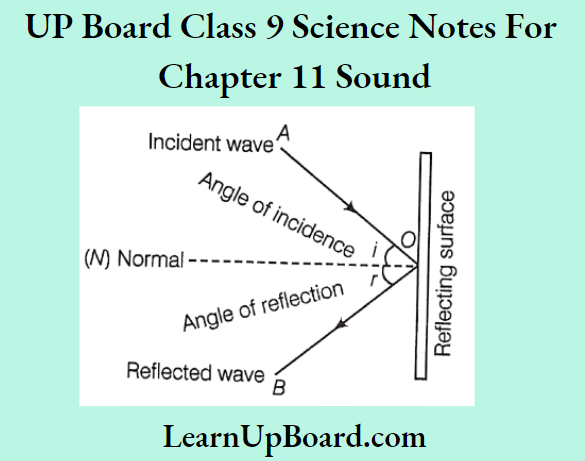
The laws of reflection of sound are as follows:
(1) The incident sound wave (AO), the reflected sound wave (OB) and the normal (ON) at the point of incidence, all lie in the same plane.
{2) The angle of incidence (∠AON) of sound is equal to the angle of reflection (∠NOB) of sound.
Question 10. When a sound is reflected from a distant object, an echo is produced. Let the distance between the reflecting surface and the source of sound production remain the same. Do you hear an echo sound on a hotter day?
Answer:
Given
When a sound is reflected from a distant object, an echo is produced. Let the distance between the reflecting surface and the source of sound production remain the same.
The time taken by echo to be heard, t = \(\frac{2 d}{v}\)
where d = distance between the reflecting surface and source of sound and v = speed of sound in air.
- As we know, the speed of sound increases with an increase in temperature, so on a hotter day, the speed of sound will be higher, so the time after which the echo is heard will decrease.
- If the time taken by the reflected sound is less than 0.1 s after the production of the original sound, then the echo is not heard.
Question 11. A stone is dropped from the top of a tower 500 m high into a pond of water at the base of the tower. When is the splash heard at the top? [Given, g = 10 ms-2 and speed of sound = 340ms-1]
Answer:
Given
A stone is dropped from the top of a tower 500 m high into a pond of water at the base of the tower.
Time after which the splash is heard = Time taken by the stone to reach the pond + Time taken by splash sound to reach the top of the tower.
(1) For the time taken by the stone to reach the pond.
Here, u=0 [stone is dropped from rest] From the equation of motion, h=\(u t+\frac{1}{2} g t^2\)
500=0 \(\times t+\frac{1}{2} \times 10(t)^2\)
500=\(5 t^2 \Rightarrow t^2=100 \Rightarrow t=\sqrt{100}=10 \mathrm{~s}\)
(2) Time taken by splash sound to reach the top of the tower \(t^{\prime}=\frac{\text { Distance }}{\text { Speed }}=\frac{500}{340}=1.47 \mathrm{~s}\)
Time after which a splash is heard
=10+1.47=11.47 s
Question 12. A sound wave travels at a speed of 339 \(\mathrm{~ms}^{-1}\). If its wavelength is 1.5 cm, then what is the frequency of the wave? Will it be audible?
Answer:
Given,
A sound wave travels at a speed of 339 \(\mathrm{~ms}^{-1}\). If its wavelength is 1.5 cm
speed, v=339 \(\mathrm{~ms}^{-1}\)
Wavelength, \(\lambda=1.5 \mathrm{~cm}=1.5 \times 10^{-2} \mathrm{~m}\)
Frequency, v=\(\frac{v}{\lambda}=\frac{339}{1.5 \times 10^{-2}}=22600 \mathrm{~Hz}\)
This frequency is greater than 20000 Hz, so it will not be audible. The audible range for the human ear is 20 Hz to 20000 Hz.
Question 13. What is reverberation? How can it be reduced?
Answer:
Reverberation
- The persistence of a sound in a big hall due to repeated reflections from the walls, ceiling and floor of the wall is known as reverberation.
- It can be reduced by covering the roofs and walls of the hall with sound-absorbing materials.
Question 14. What is the loudness of sound? What factors does it depend on?
Answer:
The loudness of sound
Loudness of a sound is a subjective quantity, it is the measure of the sound energy reaching the ear per second. Loudness depends on
- the amplitude of the vibrating body and
- the sensitivity of the human ear.
Question 15. Explain how bats use ultrasound to catch prey.
Answer:
- Bats can produce ultrasonic waves by flapping their wings, they can also detect these waves. The ultrasonic waves produced by a bat spread out.
- These waves after reflecting from a prey like an insect reach the bat. So, the bat can locate its prey.
UP Board Class 9 Science Notes For Chapter 11 Sound Summary
- Sound is produced by vibrating objects.
- Vibration means a kind of rapid-to-and-fro motion of an object.
- Compression is the part of a longitudinal wave in which the particles of a medium are closer to one another than they normally are and it is the region of high pressure.
- Rarefaction is the part of a longitudinal wave in which the particles of the medium are farther apart than they normally are and it is the region of low pressure.
- Waves are of two types (1) longitudinal waves and (2) transverse waves.
- In longitudinal waves, the individual particles of the medium move in a direction parallel to the direction of propagation of the disturbance.
- In transverse waves, the individual particles of the medium move about their mean position in a direction perpendicular to the direction of wave propagation.
- The distance between the two consecutive compressions (C) or two consecutive rarefactions (fl) is called the wavelength. Its SI unit is metre (m).
- The number of vibrations that occur per second is known as frequency. Its SI unit is Hertz (Hz).
- The time taken by two consecutive compressions or rarefactions to cross a fixed point is called the time period of the wave.
- The time period of a wave is reciprocal of its frequency, i.e. T=\(\frac{1}{\mathrm{v}}\) .
- The maximum displacement of the particles of the medium from their original mean positions on passing a wave through the medium is called the amplitude of the wave. Its SI unit is metre (m).
- The relationship between speed (v), frequency (v)and wavelength of a wave is given by v = vλ
- The measure of sound energy reaching the ear per second is known as loudness. It is measured in decibels (dB).
- The amount of sound energy passing each second through the unit area is known as the intensity of sound. Its SI unit is watt per square metre (W/m²).
- Pitch is that characteristic of sound by which we can distinguish between the different sounds of the same loudness.
- The quality or timbre of sound enables us to distinguish one sound from another having the same pitch and loudness.
- The speed of sound is greatest in solids, then in liquids and least in gases.
- When the speed of any object exceeds the speed of sound, it is said to have supersonic speed.
The bouncing back of sound when it strikes a hard surface is known as the reflection of sound. c Laws of Reflection of Sound
- The incident sound wave, reflected sound wave and the normal at the point of incidence, all lie in the same plane.
- The angle of incidence of sound is equal to the angle of reflection of sound.
The repetition of sound caused by the reflection of sound waves is called an Echo.
- The persistence of sound in a big hall due to repeated reflections from the walls, ceiling and floor is known as reverberation.
- The audible range of sound for the human ear is from 20 Hz to 20000 Hz.
- The sound of frequencies lower than 20 Hz are known as infrasonic sounds, which cannot be heard by humans.
- The sounds of frequencies higher than 20000 Hz are called ultrasonic sounds, which cannot be heard by human beings.
- Ultrasound is used to clean parts located in hard-to-reach places such as spiral tubes, and odd-shaped machines.
- Ultrasound is also used for diagnosing heart diseases by scanning the heart from the inside. This technique is called echocardiography.
- The method used by some animals like bats, tortoises and dolphins to locate objects by hearing the echoes of their ultrasonic squeaks is known as echolocation.
